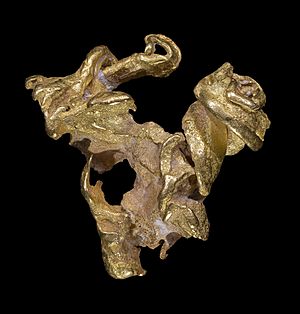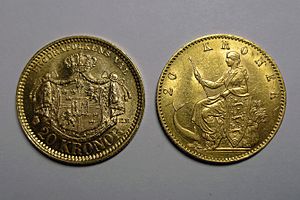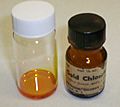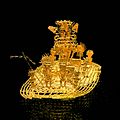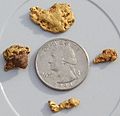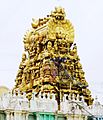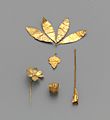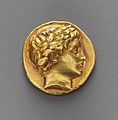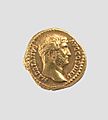Gold facts for kids
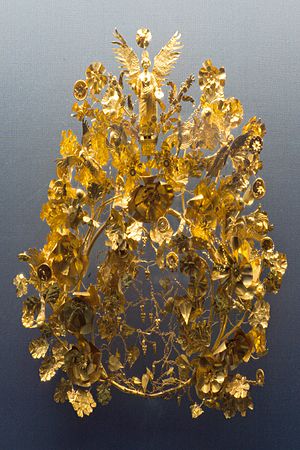
Gold is a soft, heavy, and shiny metal. It is a chemical element with the symbol Au and atomic number 79. For thousands of years, people worldwide have used gold for jewelry, decoration, and as money. Gold is special because it is rare and easy to work with. It is also used to fix teeth and in electronics like computers. The color of this metal is also called gold.
Finding gold usually involves mining, similar to other metals. Gold is so valuable that finding a new place to mine it has often led to a gold rush. Sometimes, gold is found as a "native element." This means it is pure gold and not mixed in with other rocks that need special processing. Most of the gold on Earth is deep inside the Earth's core because it is very heavy. However, nearly all the gold we find on the surface came from meteorites that hit Earth long ago.
Contents
What is Gold Chemically?
In chemistry, gold is chemical element 79. It is a transition metal in Group 11 of the periodic table. Its atomic weight is about 199.96. The symbol Au comes from the Latin word for gold, aurum. Gold is known as a "noble metal" because it does not easily react with other chemicals.
Gold is very soft. A goldsmith can hammer it into very thin sheets. It is also ductile, meaning it can be stretched into a wire. When gold is used for money or jewelry, it is often mixed with silver or other metals to make it harder. Most metals are gray, but gold is yellow because of how its electrons behave. The only other common metal that is not gray is copper.
Gold as Money
Gold has been used as money all over the world for a long time. People used it for trading and to save their wealth. To make it easier to trade, mints made standard gold bullion coins and bars with fixed weight and purity.
The first known gold coins were made in Lydia, Asia Minor, around 600 BC. The "talent" gold coin used in ancient Greece weighed about 8.42 to 8.75 grams. After preferring silver for a while, European countries started making gold coins again in the 13th and 14th centuries.
After World War II, a system called the Bretton Woods system was set up. It used currencies that could be exchanged for gold at a fixed rate. However, countries eventually stopped linking their money directly to gold. The United States stopped in 1971. Now, most money is fiat currency, which means its value comes from government trust, not from being backed by gold. Switzerland was the last country to link its currency to gold, doing so until 1999.
Even today, central banks around the world keep some of their money as gold. People also buy gold bullion coins or bars to protect their money from inflation or other economic problems.
The History of Gold

Some of the oldest gold items were found in the Nahal Kana cave cemetery. They date back to the Chalcolithic period. Gold items also appeared in the Balkans around 4000 BC, like those found in the Varna Necropolis in Bulgaria. These are thought to be the earliest "well-dated" gold artifacts. In Central Europe, gold items like golden hats and the Nebra disk appeared during the Bronze Age (2nd millennium BC).
The oldest known map of a gold mine was drawn in Ancient Egypt (1320–1200 BC). The first written mention of gold was around 1900 BC. Egyptian hieroglyphs from as early as 2600 BC describe gold. King Tushratta of the Mitanni even said that gold was "more plentiful than dirt" in Egypt. Egypt and especially Nubia were major gold-producing areas for a long time. The Turin Papyrus Map shows a gold mine in Nubia. Ancient writers like Strabo and Diodorus Siculus described how people mined gold back then, sometimes using fire to break rocks. Large mines were also found across the Red Sea in what is now Saudi Arabia.
Gold is mentioned many times in the Old Testament, starting in Genesis. It appears in stories like The Golden Calf and was used for parts of the temple, such as the Menorah. In the New Testament, gold was one of the gifts given by the magi. The Book of Revelation describes the city of New Jerusalem with streets "made of pure gold, clear as crystal."
The legend of the golden fleece might refer to how ancient people used sheepskins to catch gold dust from rivers. Gold mining in the Black Sea area is said to date back to the time of Midas. This gold was important for making the world's first coins in Lydia around 610 BC.
The Romans developed new ways to get gold on a large scale. They used hydraulic mining methods, especially in Hispania from 25 BC and in Dacia from 106 AD. One of their biggest mines was at Las Médulas in León, where they used seven long aqueducts to wash away large amounts of gold-bearing dirt. The mines at Roşia Montană in Transylvania were also very large. Pliny the Elder described these mining methods in his book Naturalis Historia.
When Mansa Musa, the ruler of the Mali Empire, traveled to Mecca in 1324, he brought so much gold that he caused its price to drop in Egypt for over ten years.
European explorers came to the Americas partly because of stories about the many gold ornaments worn by Native American peoples. This was especially true in Mesoamerica, Peru, Ecuador, and Colombia. The Aztecs believed gold was a product of the gods, calling it "god excrement." After Moctezuma II was killed, most of this gold was sent to Spain. However, for some indigenous peoples of North America, gold was not considered useful. They valued other minerals like obsidian and flint more. Rumors of cities full of gold led to the legends of El Dorado.
Gold also appears in Western culture, often linked to desire or corruption. Examples include children's fables like Rumpelstiltskin, where hay is turned into gold, and the story of the hen that lays golden eggs in Jack and the Beanstalk.
The top prize at the Olympic Games and many other sports competitions is the gold medal.
About 75% of the gold we know about today has been dug up since 1910. It's estimated that all the gold ever found would fit into a single cube about 20 meters (66 feet) on each side.
Golden treasures are often rumored to be found after tragedies. For example, the Jewish temple treasures in the Vatican, gold on the Titanic, and the Nazi gold train after World War II.
Many famous buildings are covered in gold. The Dome of the Rock has a very thin golden layer. The Sikh Harmandir Sahib is covered in gold. The Wat Phra Kaew emerald Buddhist temple in Thailand has gold-leafed statues and roofs. Some European kings and queens wore crowns made of gold. Gold was also used for bridal crowns in ancient times. An old text from around 100 AD describes a "Jerusalem of Gold" diadem given to Rachel, wife of Rabbi Akiva. A Greek burial crown made of gold was found from around 370 BC.
Gold in Culture
Great human achievements are often rewarded with gold. This includes gold medals, gold trophies, and other awards. Winners of sports events and other contests usually get a gold medal. Many awards, like the Nobel Prize, are made from gold or are gold plated. Examples include the Academy Awards, the Golden Globe Awards, the Emmy Awards, the Palme d'Or, and the British Academy Film Awards.
Aristotle used gold as a symbol in his ideas about the "golden mean," which means finding a balance. Gold is also linked to perfect ideas, like the golden ratio in math and the golden rule for how we should treat others.
Gold is also connected to wisdom and success that comes with age. A fiftieth wedding anniversary is called a "golden" anniversary. A person's most successful later years are sometimes called their "golden years." The best time of a civilization is called a "golden age."
In some forms of Christianity and Judaism, gold has been seen as both holy and sometimes linked to evil.
Christopher Columbus believed that having gold was very valuable on Earth and could even help souls reach paradise.
Wedding rings have often been made of gold. Because gold lasts a long time and doesn't change, it helps symbolize eternal promises in marriage. In Orthodox Christian weddings, the couple wears a golden crown during the ceremony.
How Gold is Produced
The World Gold Council says that by the end of 2017, there were 187,200 tonnes of gold above ground. This amount would fit into a cube with sides about 21 meters long.
As of 2017, China was the world's biggest gold producer, mining 455 tonnes. Australia was second with 270 tonnes, followed by Russia with 250 tonnes.
Gold Mining and Finding It
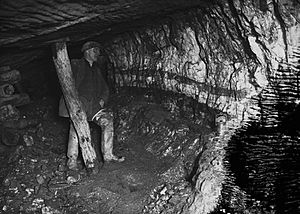
Since the 1880s, South Africa has produced a large amount of the world's gold. About 50% of the gold we know about today comes from South Africa. In 1970, South Africa produced 79% of the world's gold. In 2007, China became the largest gold producer, which was the first time since 1905 that South Africa was not number one.
As of 2014, China was still the top gold-mining country. After China came Australia, Russia, the United States, Canada, and Peru. South Africa, which was number one for most of the 20th century, had dropped to sixth place. Other big producers include Ghana, Burkina Faso, Mali, Indonesia, and Uzbekistan.
In South America, there is a project called Pascua Lama that aims to mine gold in the high mountains between Chile and Argentina. Today, about a quarter of the world's gold comes from small-scale mining.
The city of Johannesburg in South Africa was founded because of the Witwatersrand Gold Rush. This led to the discovery of some of the biggest natural gold deposits ever found.
During the 19th century, gold rushes happened whenever large gold deposits were found. The first gold discovery in the United States was at the Reed Gold Mine in North Carolina in 1803. The first major gold strike in the U.S. happened in Dahlonega, Georgia. Other famous gold rushes happened in California, Colorado, the Black Hills, Otago in New Zealand, Australia, Witwatersrand in South Africa, and the Klondike in Canada.
Images for kids
-
A gold nugget about 5 mm in size can be hammered into a gold foil about 0.5 square meters in area.
-
A diagram showing a cross-section of the 2.02-billion-year-old Vredefort impact structure in South Africa. It shows how the impact changed the rock layers. Johannesburg is located where the Witwatersrand Basin (the yellow layer) is at the surface, near the crater rim.
-
An Indian tribute-bearer at Apadana, from the Achaemenid satrapy of Hindush, carrying gold on a yoke, around 500 BC.
-
The Muisca raft, from between 600-1600 AD. This figure shows the ceremony from the legend of El Dorado. The zipa would cover himself in gold dust and offer treasures to the Guatavita goddess in the middle of a sacred lake from his raft. This old Muisca tradition started the legend of El Dorado. This Muisca raft figure is at the Gold Museum, Bogotá, Colombia.
-
A gold coin of Eucratides I (171–145 BC), one of the Hellenistic rulers of ancient Ai-Khanoum. This is the largest known gold coin made in ancient times (169.2 g; 58 mm).
-
An early mention of gold in the epic poem Beowulf.
-
The Agusan image, a solid gold statue of a deity from northeast Mindanao, 13th century.
-
The relative sizes of an 860 kg block of gold ore and the 30 g of gold that can be taken from it, at the Toi gold mine, Japan.
-
Gold prospecting at the Ivalo River in the Finnish Lapland in 1898.
-
Gold Nuggets found in Arizona.
-
Two golden 20 kr coins from the Scandinavian Monetary Union, which used a gold standard. The coin on the left is Swedish and the one on the right is Danish.
-
Moche gold necklace showing feline heads. From the Larco Museum Collection, Lima, Peru.
-
A 21.5k yellow gold pendant watch called a "Boule de Genève" (Geneva ball), from around 1890.
-
A cake with gold decoration served at the Amstel Hotel, Amsterdam.
-
A mirror for the James Webb Space Telescope coated in gold to reflect infrared light.
-
Kamakshi Amman Temple with a golden roof, Kanchipuram.
-
Minoan jewelry; 2300–2100 BC; various sizes; Metropolitan Museum of Art (New York City).
-
A pair of Sumerian earrings with cuneiform writing; 2093–2046 BC; Sulaymaniyah Museum (Sulaymaniyah, Iraq).
-
An Ancient Egyptian statuette of Amun; 945–715 BC; gold; 175x47 mm; Metropolitan Museum of Art.
-
An Ancient Egyptian signet ring; 664–525 BC; gold; diameter: 30 x 34 mm; British Museum (London).
-
An Ancient Greek stater; 323–315 BC; 18 mm; Metropolitan Museum of Art.
-
An Etruscan funerary wreath; 4th–3rd century BC; length: 333 mm; Metropolitan Museum of Art.
-
A Pre-Columbian pendant with two bat-head warriors carrying spears; 11th–16th century; gold; overall: 76.2 mm; from the Chiriqui Province (Panama); Metropolitan Museum of Art.
-
An English Neoclassical box; 1741; overall: 44 x 116 x 92 mm; Metropolitan Museum of Art.
See also
 In Spanish: Oro para niños
In Spanish: Oro para niños


